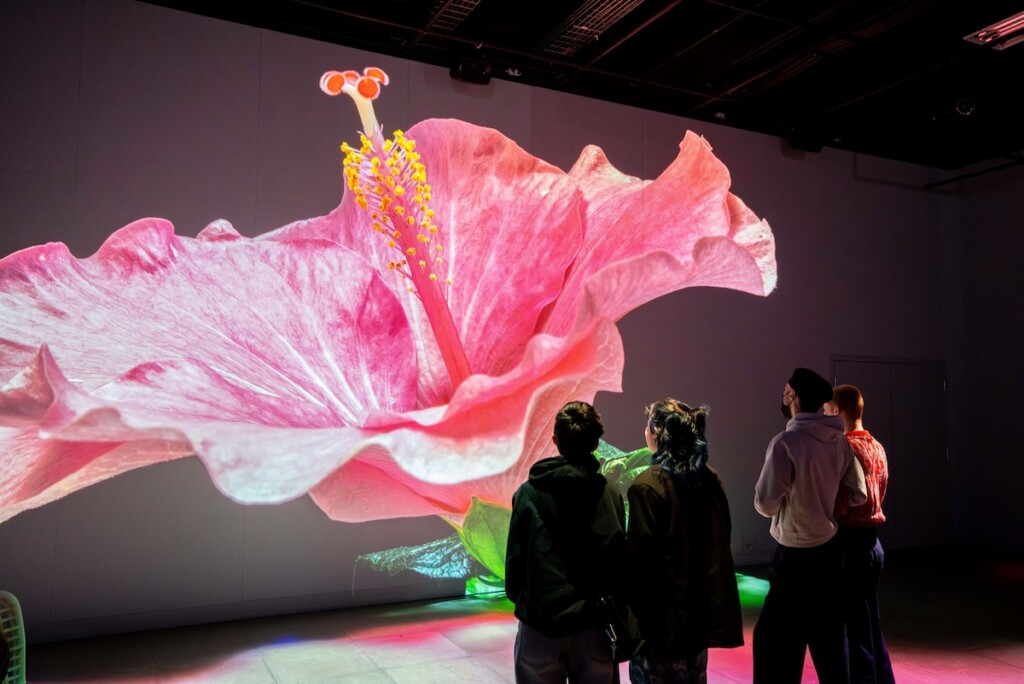
The exhibit is structured to guide visitors through different ecosystems and environments, using every sense to engage them fully.
The exhibition immerses visitors with projections of natural environments that shift seamlessly as they move through the space and offers a full sensory experience, enhanced by dynamic soundscapes. The visuals are not only stunning but educational, providing guests with real-world insights into these ecosystems.This multi-sensory approach allows guests to connect more deeply with nature, ensuring the experience remains impactful.
The storytelling in ”Root for Nature” is both an artistic and educational triumph. It tells the story of our planet’s ecosystems in a way that resonates deeply with visitors of all ages. The narrative unfolds as guests move through the exhibition, each room presenting a new chapter in nature’s tale—from the delicate balance of rainforests to the vast, unexplored mysteries of the ocean.
The journey begins with the Anticipation Room, where the story sets the tone for exploration and discovery. The pacing of the exhibition mirrors that of a dramatic narrative, starting with awe and wonder as guests experience the beauty of the natural world. However, as they progress through the exhibit, the story transitions into moments of reflection and responsibility, asking visitors to consider their impact on the environment.
The interactivity reinforces the narrative, allowing guests to play a direct role in the preservation efforts presented within the exhibition. By making the story personal and participatory, ”Root for Nature” ensures that the message sticks long after visitors leave.

The visual storytelling is designed to evoke a range of emotions. Large-scale projections show both the grandeur and intricacy of the natural world, from expansive landscapes to close-up shots of individual species. In one room, guests might find themselves enveloped by a forest canopy, with sunlight streaming through digital leaves, while in another, they are plunged into the depths of the ocean, surrounded by vibrant coral reefs. Each shift in environment is carefully orchestrated to enhance the overall narrative, using visual cues to signal changes in tone and theme.
At its core, ”Root for Nature” is an educational exhibit, but the storytelling is what makes it memorable. Rather than simply presenting facts, the exhibit uses a narrative structure to guide visitors through complex environmental issues, such as biodiversity loss, climate change, and conservation efforts.

The exhibition also uses art installations to further the narrative. For example, the Chromatic Coral Prints installation is a metaphor for the regenerative power of nature, highlighting how even in times of crisis, ecosystems have the capacity to recover. These artistic elements are woven seamlessly into the storytelling, providing moments of introspection and emotional resonance.
The technology used in ”Root for Nature” plays a critical role in bringing the story to life, but it does so in a way that supports, rather than overshadows, the narrative. From wall-to-wall gesture-based interactivity that fully engages visitors to motion-sensor interactivity, the technology is seamlessly integrated into the storytelling experience, allowing visitors to engage more deeply with the content.
The sound design is another crucial component of the storytelling. The exhibition’s design is meticulously crafted to reflect the narrative at every turn. The choice of colors, lighting, and space all contribute to the storytelling, ensuring that every element of the experience feels cohesive and purposeful.
The story doesn’t end when the exhibition is over. Instead, visitors leave with a clear message: that they, too, are part of the story. By framing the narrative as a journey that continues outside the exhibition hall, ”Root for Nature” encourages guests to take what they’ve learned and apply it to their own lives. The Regeneration Lounge, serves as a space for reflection, where guests can explore global conservation initiatives and learn how they can get involved.
The result is a storytelling experience that is not only engaging but deeply impactful, leaving visitors with a renewed sense of connection to the natural world and a desire to be part of the solution.

Educational Integration
The exhibit integrates educational content into its design seamlessly. Informational panels and touchpoints provide real-time data on species, ecosystems, and conservation efforts, creating moments for learning without breaking the immersive flow. Additionally, educational workshops and art installations, such as the Regeneration Lounge, offer a space for reflection, where visitors can engage with global environmental efforts and explore how they can contribute to achieving the Kunming-Montréal Global Biodiversity Framework goals of protecting 30% of the planet’s ecosystems by 2030.

Theming and Design Choices
The exhibit is designed with a fluid journey in mind, allowing guests to move through different biomes and ecosystems with ease. The layout mirrors the interconnectedness of nature, where every step flows naturally into the next environment. Each chapter of the exhibition, from the Anticipation Room to the Regeneration Lounge, is meticulously designed to evoke awe, curiosity, and responsibility for the planet.
Immersive Set Design
The visuals are accompanied by intricate set designs that blend natural materials and art installations, giving visitors the sense of physically stepping into nature. The Chromatic Prints art installation representing corals at the end, serves as a visual metaphor for nature’s ability to regenerate and adapt, emphasizing the hope and potential for recovery in the natural world.

Emotional Storytelling
The thematic approach isn’t just about showcasing nature’s beauty; it’s about igniting emotions. Each section of the exhibit emphasizes our intrinsic bond to the natural world and highlights the impact of human actions. From moments of awe when viewing the beauty of wildlife, to reflective spaces where solutions are presented, the emotional arc is designed to inspire both action and optimism.

Technology as a Tool for Learning and Immersion
At its core, the technology behind ”Root for Nature” enhances the learning experience without overwhelming it. The integration of laser phosphor projectors, interactive touchpoints, and synchronized audio systems ensures that visitors are fully immersed, but the focus always remains on the natural world, not the tools used to showcase it.
Art as an Educational Medium: The exhibition’s art installations, such as Chromatic Prints, also serve as educational tools. Visitors are invited to reflect on how small actions can have a large-scale impact on biodiversity, fostering a sense of personal responsibility toward conservation efforts.

Educational Workshops and the Role of Art
The Regeneration Lounge serves as a dedicated space for educational workshops and reflection. This section of the exhibit offers hands-on activities that teach visitors about biodiversity, climate change, and what they can do to make a difference. These workshops are especially engaging for school groups and families, offering a deeper dive into environmental issues in a format that is both educational and engaging.

Partners
- National Geographic
- United Nations
- Convention of Biological Diversity
- David Suzuki Foundation
- Palais des congrès de Montréal
- Tourisme Montréal


